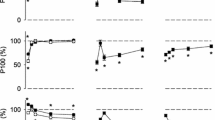Summary
Ten male subjects were tested to determine the effects of muscle fatigue upon the activation pattern of the two main ankle extensor muscles, the ‘slow-twitch’ soleus (SOL) and the relatively ‘fast-twitchrs medial gastrocnemius (MG), during a fatiguing 60-s trial of hopping to maximal height. The myoelectric signals from SOL and MG were recorded together with the vertical ground reaction force signal and analysed by means of a computer-aided electromyograph (EMG) contour analysis, i.e. two-dimensional frequency distributions were obtained relating the activation patterns of the two synergists. The EMGs were also full-wave rectified and integrated (IEMG) according to three phases of the hopping movement (PRE, pre-activation phase; ECC, eccentric phase; CON, concentric phase). Results indicated that there were significant decreases (P<0.01) in the peak ground reaction force, the height of hopping and the mechanical power per unit body weight at the end of the fatiguing contractions. These decreases in mechanical parameters were accompanied by significant (P<0.01) decreases in all three phases of MG IEMG while SOL IEMG showed no such significant declines, except in the CON phase. Thus, the decreased mechanical parameters could in large part be accounted for by the substantial and selective decline of the excitation level of the relatively fast-twitch MG muscle. Our data suggest that the centrally mediated pre-activation of the fatiguable MG muscle as well as the MG activation during the eccentric phase, which is largely controlled by supraspinal inputs and stretch-reflex modulation, are most affected by fatigue changes during repeated maximal stretch/shortening cycles of the ankle extensors.
Similar content being viewed by others
References
Asmussen E, Bonde-Petersen F (1974) Storage of elastic energy in skeletal muscles in man. Acta Physiol Scand 91:385–392
Bigland-Ritchie B, Jones DA, Woods JJ (1979) Excitation frequency and muscle fatigue: electrical responses during human voluntary and stimulated contractions. Exp Neurol 64:414–427
Bigland-Ritchie B, Johansson R, Lippold OCJ, Woods JJ (1983) Contractile speed and EMG changes during fatigue of sustained maximal voluntary contractions. J Neurophysiol 50:313–324
Bosco C, Tarkka I, Komi PV (1982a) Effect of elastic energy and myoelectric potentiation of triceps surae during stretch-shortening cycle exercise. Int J Sports Med 3:137–140
Bosco C, Viitasalo JT, Komi PV, Luhtanen P (1982b) Combined effect of elastic energy and myoelectric potentiation during stretch-shortening cycle exercise. Acta Physiol Scand 114:557–565
Bosco C, Tihanyi J, Latteri F, Fekete G, Apor P, Rusko H (1986) The effect of fatigue on store and re-use of elastic energy in slow and fast types of human skeletal muscle. Acta Physiol Scand 128:109–117
Bosco C, Montanari G, Tarkka I, Latteri F, Cozzi M, Iachelli G, Faina M, Colli R, Dal Monte A, La Rosa M, Ribacchi R, Giovenali P, Cortili G, Saibene F (1987) The effect of prestretch on mechanical efficiency of human skeletal muscle. Acta Physiol Scand 131:323–329
Cavagna GA (1978) Aspects of efficiency and inefficiency of terrestrial locomotion. In: Asmussen E, Jorgrensen K (eds) Biomechanics IV-A. University Park Press, Baltimore, pp 3–22
Cavagna GA, Kaneko M (1977) Mechanical work and efficiency in level walking and running. J Physiol (Lond) 268:467–481
Dietz V, Schmidtbleicher D, Hainaut K (14979) Neural mechanisms of human locomotion. J Neurophysiol 42:1212–1222
Dietz V, Noth J, Schmidtbleicher D (1981) Interaction between pre-activity and stretch reflex in human triceps brachii during landing from forward falls. J Physiol (Lond) 311:113–125
Friden J, Sjostrom M, Ekblom B (1983) Myofibrillar damage following intense eccentric exercise in man. Int J Sports Med 4:170–176
Gollhofer A, Komi PV, Miyashita M, Aura O (1987) Fatigue during stretch-shortening cycle exercise: changes in mechanical performance of human skeletal muscle. Int J Sports Med 8:71–78
Grillner S (1972) The role of muscle stiffness in meeting the changing postural and locomotor requirements for force development by the ankle extensors. Acta Physiol Scand 86:92–108
Hodgson JA (1983) The relationship between soleus and gastrocnemius muscle activity in conscious cats — a model for motor unit recruitment? J Physiol (Lond) 337:553–562
Kaneko M, Komi PV, Aura O (1984) Mechanical efficiency of eccentric and concentric exercises performed with medium to fast contraction rates. Scand J Sport Sci 6:15–20
Komi PV (1984) Physiological and biomechanical correlates of muscles function: effect of muscle structure and stretch-shortening cycle on force and speed. Exerc Sports Sci Rev 12:81–121
Komi PV, Viitasalo JT (1977) Changes in motor unit activity and metabolism in human skeletal muscle during and after repeated eccentric and concentric contractions. Acta Physiol Scand 100:246–254
Komi PV, Kaneko M, Aura O (1987) EMG activity of the leg extensor muscles with special reference to mechanical efficiency in concentric and eccentric exercise. Int J Sports Med 8:22–29
Moritani T, Muro M (1987) Motor unit activity and surface electromyogram power spectrum during increasing force of contraction. Eur J Appl Physiol 56:260–265
Moritani T, Muro M, Kijima A (1985a) Electromechanical changes during electrically induced and maximal voluntary contractions: electrophysiologic responses of different muscle fiber types during stimulated contractions. Exp Neurol 88:471–483
Moritani T, Muro M, Kijima A, Gaffney FA, Persons D (1985b) Electromechanical changes during electrically induced and maximal voluntary contractions: surface and intramuscular EMG responses during sustained maximal voluntary contraction. Exp Neurol 88:484–499
Moritani T, Muro M, Nagata A (1986) Intramuscular and surface electromyogram changes during muscle fatigue. J Appl Physiol 60:1179–1185
Moritani T, Muramatsu S, Muro M (1988) Activity of motor units during concentric and eccentric contractions. Am J Phys Med 66:338–350
Newham DJ, Mills KR, Quigley BM, Edwards RHT (1983) Pain and fatigue after concentric and eccentric muscle contractions. Clin Sci 64:55–62
Saltin B, Gollnick PD (1983) Skeletal muscle adaptability: significance for metabolism and performance. In: American Physiologial Society, Handbook of physiology, sect 10. Maryland, p 555–631
TECA corporation (1972) Motorpoint charts and chronaxie values. New York, pp 1–18
Author information
Authors and Affiliations
Rights and permissions
About this article
Cite this article
Moritani, T., Oddson, L. & Thorstensson, A. Electromyographic evidence of selective fatigue during the eccentric phase of stretch/shortening cycles in man. Europ. J. Appl. Physiol. 60, 425–429 (1990). https://doi.org/10.1007/BF00705031
Accepted:
Issue Date:
DOI: https://doi.org/10.1007/BF00705031




